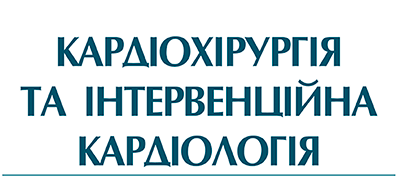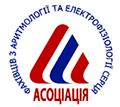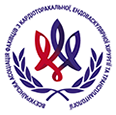Almanac 2012 – adult cardiac surgery: the national society journals present selected research that has driven recent advances in clinical cardiology
B. Bridgewater
References
1. Bridgewater B., Kinsman R., Walton P. et al. Demonstrating Quality; The Sixth National Annual Cardiac Database Report.– Henley-on-Thames: Dendrite Clinical Systems Ltd, 2009.
2. El Bardissi A.W., Aranki S.F., Sheng S. et al. Trends in isolated coronary artery bypass grafting: an analysis of the Society of Thoracic Surgeons adult cardiac surgery database // J. Thorac. Cardiovasc. Surg.– 2012.– Vol. 143.– P. 273–281.
3. Bridgewater B. Cardiac registers: the adult cardiac surgery register // Heart.– 2010.– Vol. 96.– P. 1441–1443.
4. Serruys P.W., Morice M.C., Kappetein A.P. et al. Percutaneous coronary intervention versus coronary-artery bypass grafting for severe coronary artery disease // N. Engl. J. Med.– 2009.– Vol. 360.– P. 961–972.
5. Kappetein A.P., Feldman T.E., Mack M.J. et al. Comparison of coronary bypass surgery with drug-eluting stenting for the treatment of left main and/or three-vessel disease: 3-year follow-up of the SYNTAX trial // Eur. Heart. J.– 2011.– Vol. 32.– P. 2125–2134.
6. Weintraub W.S., Grau-Sepulveda M.V., Weiss J.M. et al. Comparative effectiveness of revascularization strategies // N. Engl. J. Med.– 2012.– Vol. 366.– P. 1467–1476.
7. Lee M.S., Yang T., Dhoot J. et al. Meta-analysis of clinical studies comparing coronary artery bypass grafting with percutaneous coronary intervention and drug-eluting stents in patients with unprotected left main coronary artery narrowings // Amer. J. Cardiol.– 2010.– Vol. 105.– P. 1070–1075.
8. Naik H., White A.J., Chakravarty T. et al. A meta-analysis of 3,773 patients treated with percutaneous coronary intervention or surgery for unprotected left main coronary artery stenosis // JACC Cardiovasc. Interv.– 2009.– Vol. 2.– P. 739–747.
9. Morice M.C., Serruys P.W., Kappetein A.P. et al. Outcomes in patients with de novo left main disease treated with either percutaneous coronary intervention using paclitaxel-eluting stents or coronary artery bypass graft treatment in the Synergy Between Percutaneous Coronary Intervention with TAXUS and Cardiac Surgery (SYNTAX) trial // Circulation.– 2010.– Vol. 121.– P. 2645–2653.
10. Park S.J., Kim Y.H., Park D.W. et al. Randomized trial of stents versus bypass surgery for left main coronary artery disease // N. Engl. J. Med.– 2011.– Vol. 364.– P. 1718–1727.
11. Boudriot E., Thiele H., Walther T. et al. Randomized comparison of percutaneous coronary intervention with sirolimus-eluting stents versus coronary artery bypass grafting in unprotected left main stem stenosis // J. Amer. Coll. Cardiol.– 2011.– Vol. 57.– P. 538–545.
12. Capodanno D., Tamburino C. Unraveling the EXCEL: promises and challenges of the next trial of left main percutaneous coronary intervention // Int. J. Cardiol.– 2012.– Vol. 156.– P. 1–3.
13. Capodanno D., Caggegi A., Capranzano P. et al. Validating the EXCEL hypothesis: a propensity score matched 3-year comparison of percutaneous coronary intervention versus coronary artery bypass graft in left main patients with SYNTAX score </¼32 // Catheter. Cardiovasc. Interv.– 2011.– Vol. 77.– P. 936–943.
14. Wijns W., Kolh P., Danchin N. et al. Guidelines on myocardial revascularization // Eur. Heart J.– 2010.– Vol. 31.– P. 2501–2555.
15. Ribichini F., Taggart D. Implications of new ESC/EACTS guidelines on myocardial revascularisation for patients with multi-vessel coronary artery disease // Eur. J. Cardiothorac. Surg.– 2011.– Vol. 39.– P. 619–622.
16. Taggart D.P., Boyle R., de Belder M.A. et al. The 2010 ESC/EACTS guidelines on myocardial revascularization // Heart.– 2011.– Vol. 97.– P. 445–446.
17. Falk V., Taggart D.P. NICE guidance for off-pump CABG: turn off the pump // Heart.– 2011.– Vol. 97.– P. 1731–1733.
18. Pepper J.R. NICE guidance for off-pump CABG: keep the pump primed // Heart.– 2011.– Vol. 97.– P. 1728–1730.
19. Shroyer A.L., Grover F.L., Hattler B. et al. On-pump versus off-pump coronary-artery bypass surgery // N. Engl. J. Med.– 2009.– Vol. 361.– P. 1827–1837.
20. Puskas J.D., Mack M.J., Smith C.R. On-pump versus off-pump CABG // N. Engl. J. Med.– 2010.– Vol. 362.– P. 851.
21. Zenati M.A., Shroyer A.L., Collins J.F. et al. Impact of endoscopic versus open saphenous vein harvest technique on late coronary artery bypass grafting patient outcomes in the ROOBY (Randomized On/Off Bypass) Trial // J. Thorac. Cardiovasc. Surg.– 2011.– Vol. 141.– P. 338–344.
22. Moller C.H., Perko M.J., Lund J.T. et al. Three-year follow-up in a subset of high-risk patients randomly assigned to off-pump versus on-pump coronary artery bypass surgery: the Best Bypass Surgery trial // Heart.– 2011.– Vol. 97.– P. 907–913.
23. Hueb W., Lopes N.H., Pereira A.C. et al. Five-year follow-up of a randomized comparison between off-pump and on-pump stable multivessel coronary artery bypass grafting. The MASS III Trial // Circulation.– 2010.– Vol. 122 (Suppl. 11).–P. S48–52.
24. Lamy A., Devereaux P.J., Prabhakaran D. et al. Off-pump or on-pump coronary-artery bypass grafting at 30 days // N. Engl. J. Med.– 2012.– Vol. 366 (16).– P. 1489–1497.
25. Kuss O., von Salviati B., Borgermann J. Off-pump versus on-pump coronary artery bypass grafting: a systematic review and meta-analysis of propensity score analyses // J. Thorac. Cardiovasc. Surg.– 2010.– Vol. 140.– P. 829-835.
26. Puskas J.D., Thourani V.H., Kilgo P. et al. Off-pump coronary artery bypass disproportionately benefits high-risk patients // Ann. Thorac. Surg.– 2009.– Vol. 88.– P. 1142–1147.
27. Angelini G.D., Culliford L., Smith D.K. et al. Effects of on- and off-pump coronary artery surgery on graft patency, survival, and health-related quality of life: long-term follow-up of 2 randomized controlled trials // J. Thorac. Cardiovasc. Surg.– 2009.– Vol. 137.– P. 295–303.
28. Anastasiadis K., Argiriadou H., Kosmidis M.H. et al. Neurocognitive outcome after coronary artery bypass surgery using minimal versus conventional extracorporeal circulation: a randomised controlled pilot study // Heart.– 2011.– Vol. 97.– P. 1082–1088.
29. Lopes R.D., Hafley G.E., Allen K.B. et al. Endoscopic versus open vein-graft harvesting in coronary-artery bypass surgery // N. Engl. J. Med.– 2009.– Vol. 361.– P. 235–244.
30. Grant S.W., Grayson A.D., Zacharias J. et al. What is the impact of endoscopic vein harvesting on clinical outcomes following coronary artery bypass graft surgery? // Heart.– 2012.– Vol. 98.– P. 60–64.
31. Ouzounian M., Hassan A., Buth K.J. et al. Impact of endoscopic versus open saphenous vein harvest techniques on outcomes after coronary artery bypass grafting // Ann. Thorac. Surg.– 2010.– Vol. 89.– P. 403–408.
32. Taggart D.P., Altman D.G., Gray A.M. et al. Randomized trial to compare bilateral vs. single internal mammary coronary artery bypass grafting: 1-year results of the Arterial Revascularisation Trial (ART) // Eur. Heart. J.– 2010.– Vol. 31.– P. 2470–2481.
33. Grau J.B., Ferrari G., Mak A.W. et al. Propensity matched analysis of bilateral internal mammary artery versus single left internal mammary artery grafting at 17-year follow-up: validation of a contemporary surgical experience // Eur. J. Cardiothorac. Surg.– 2012.– Vol. 41.– P. 770–775.
34. Goldman S., Sethi G.K., Holman W. et al. Radial artery grafts vs saphenous vein grafts in coronary artery bypass surgery: a randomized trial // JAMA.– 2011.– Vol. 305.– P. 167–174.
35. Levisman J.M., Budoff M.J., Karlsberg R.P. Long-term coronary artery graft patency as evaluated by 64-slice coronary computed tomographic angiography // Coron. Artery Dis.– 2011.– Vol. 22.– P. 521–525.
36. Achouh P., Boutekadjirt R., Toledano D. et al. Long-term (5- to 20-year) patency of the radial artery for coronary bypass grafting // J. Thorac. Cardiovasc. Surg.– 2010.– Vol. 140.– P. 73–79.
37. Hayward P.A., Buxton B.F. The Radial Artery Patency and Clinical Outcomes trial: design, intermediate term results and future direction // Heart Lung Circ.– 2011.– Vol. 20.– P. 187–192.
38. Hayward P.A., Gordon I.R., Hare D.L. et al. Comparable patencies of the radial artery and right internal thoracic artery or saphenous vein beyond 5 years: results from the Radial Artery Patency and Clinical Outcomes trial // J. Thorac. Cardiovasc. Surg.– 2010.– Vol. 139.– P. 60–65.
39. Pegg T.J., Maunsell Z., Karamitsos T.D. et al. Utility of cardiac biomarkers for the diagnosis of type V myocardial infarction after coronary artery bypass grafting: insights from serial cardiac MRI // Heart.– 2011.– Vol. 97.– P. 810–816.
40. Westenbrink B.D., Kleijn L., de Boer R.A. et al. Sustained postoperative anaemia is associated with an impaired outcome after coronary artery bypass graft surgery: insights from the IMAGINE trial // Heart.– 2011.– Vol. 97.– P. 1590–1596.
41. Smith K.M., McKelvie R.S., Thorpe K.E. et al. Six-year follow-up of a randomised controlled trial examining hospital versus home-based exercise training after coronary artery bypass graft surgery // Heart.– 2011.– Vol. 97.– P. 1169–1174.
42. Velazquez E.J., Lee K.L., Deja M.A. et al. Coronary-artery bypass surgery in patients with left ventricular dysfunction // N. Engl. J. Med.– 2011.– Vol. 364.– P. 1607–1616.
43. Bonow R.O., Maurer G., Lee K.L. et al. Myocardial viability and survival in ischemic left ventricular dysfunction // N. Engl. J. Med.– 2011.– Vol. 364.– P. 1617–1625.
44. Mack M.J. Coronary artery disease: how should the STICH trial results affect clinical practice? // Nat. Rev. Cardiol.– 2011.– Vol. 8.– P. 427–428.
45. Velazquez E.J., Williams J.B., Yow E. et al. Long-term survival of patients with ischemic cardiomyopathy treated by coronary artery bypass grafting versus medical therapy // Ann. Thorac. Surg.– 2012.– Vol. 93.– P. 523–530.
46. Brown J.M., O’Brien S.M., Wu C. et al. Isolated aortic valve replacement in North America comprising 108,687 patients in 10 years: changes in risks, valve types, and outcomes in the Society of Thoracic Surgeons National Database // J. Thorac. Cardiovasc. Surg.– 2009.– Vol. 137.– P. 82–90.
47. Cockburn J., Trivedi U., Hildick-Smith D. Transaortic transcatheter aortic valve implantation within a previous bioprosthetic aortic valve replacement // Catheter. Cardiovasc. Interv.– 2011.– Vol. 78.– P. 479–484.
48. Dunning J., Gao H., Chambers J. et al. Aortic valve surgery: marked increases in volume and significant decreases in mechanical valve usedan analysis of 41,227 patients over 5 years from the Society for Cardiothoracic Surgery in Great Britain and Ireland National database // J. Thorac. Cardiovasc. Surg.– 2011.– Vol. 142.– P. 776–782.
49. Grant S.W., Devbhandari M.P., Grayson A.D. et al. What is the impact of providing a transcatheter aortic valve implantation service on conventional aortic valve surgical activity: patient risk factors and outcomes in the first 2 years // Heart.– 2010.– Vol. 96.– P. 1633–1637.
50. Kang D.H., Park S.J., Rim J.H. et al. Early surgery versus conventional treatment in asymptomatic very severe aortic stenosis // Circulation.– 2010.– Vol. 121.– P. 1502–1509.
51. Brown M.L., Pellikka P.A., Schaff H.V. et al. The benefits of early valve replacement in asymptomatic patients with severe aortic stenosis // J. Thorac. Cardiovasc. Surg.– 2008.– Vol. 135.– P. 308–315.
52. Le Tourneau T., Pellikka P.A., Brown M.L. et al. Clinical outcome of asymptomatic severe aortic stenosis with medical and surgical management: importance of STS score at diagnosis // Ann. Thorac. Surg.– 2010.– Vol. 90.– P. 1876–1883.
53. Avakian S.D., Grinberg M., Ramires J.A. et al. Outcome of adults with asymptomatic severe aortic stenosis // Int. J. Cardiol.– 2008.– Vol. 123.– P. 322–327.
54. Leon M.B., Smith C.R., Mack M. et al. Transcatheter aortic-valve implantation for aortic stenosis in patients who cannot undergo surgery // N. Engl. J. Med.– 2010.– Vol. 363.– P. 1597–1607.
55. Reynolds M.R., Magnuson E.A., Lei Y. et al. Health-related quality of life after transcatheter aortic valve replacement in inoperable patients with severe aortic stenosis // Circulation.– 2011.– Vol. 124.– P. 1964–1972.
56. Reynolds M.R., Magnuson E.A., Wang K. et al. Cost-effectiveness of transcatheter aortic valve replacement compared with standard care among inoperable patients with severe aortic stenosis: results from the placement of aortic transcatheter valves (PARTNER) trial (Cohort B) // Circulation.– 2012.– Vol. 125.– P. 1102–1109.
57. Smith C.R., Leon M.B., Mack M.J. et al. Transcatheter versus surgical aortic-valve replacement in high-risk patients // N. Engl. J. Med.– 2011.– Vol. 364.– P. 2187–2198.
58. Kodali S.K., Williams M.R., Smith C.R. et al. Two-year outcomes after transcatheter or surgical aortic-valve replacement // N. Engl. J. Med.– 2012.– Vol. 366.– P. 1686–1695.
59. Moat N.E., Ludman P., de Belder M.A. et al. Long-term outcomes after transcatheter aortic valve implantation in high-risk patients with severe aortic stenosis: the U.K. TAVI (United Kingdom Transcatheter Aortic Valve Implantation) Registry // J. Amer. Coll. Cardiol.– 2011.– Vol. 58.– P. 2130–2138.
60. Zahn R., Gerckens U., Grube E. et al. Transcatheter aortic valve implantation: first results from a multi-centre real-world registry // Eur. Heart J.– 2011.– Vol. 32.– P. 198–204.
61. Lefevre T., Kappetein A.P., Wolner E. et al. One year follow-up of the multi-centre European PARTNER transcatheter heart valve study // Eur. Heart J.– 2011.– Vol. 32.– P. 148–157.
62. Gilard M., Eltchaninoff H., Iung B. et al. Registry of transcatheter aortic-valve implantation in high-risk patients // N. Engl. J. Med.– 2012.– Vol. 366.– P. 1705–1715.
63. Ussia G.P., Barbanti M., Colombo A. et al. Impact of coronary artery disease in elderly patients undergoing transcatheter aortic valve implantation: insight from the Italian CoreValve Registry // Int. J. Cardiol.– Published Online First: 27 March 2012 PMID: 22459391.
64. Eltchaninoff H., Durand E., Borz B. et al. Prospective analysis of 30-day safety and performance of transfemoral transcatheter aortic valve implantation with Edwards SAPIEN XT versus SAPIEN prostheses // Arch. Cardiovasc. Dis.– 2012.– Vol. 105.– P. 132–140.
65. Bapat V., Khawaja M.Z., Attia R. et al. Transaortic Transcatheter Aortic valve implantation using Edwards Sapien valve: a novel approach // Catheter. Cardiovasc. Interv.– 2012.– Vol. 79.– P. 733–740.
66. Litzler P.Y., Borz B., Smail H. et al. Transapical aortic valve implantation in Rouen: four years’ experience with the Edwards transcatheter prosthesis // Arch. Cardiovasc. Dis.– 2012.– Vol. 105.– P. 141–145.
67. Murtuza B., Pepper J.R., Stanbridge R.D. et al. Minimal access aortic valve replacement: is it worth it? // Ann. Thorac. Surg.– 2008.– Vol. 85.– P. 1121–1131.
68. Brown M.L., McKellar S.H., Sundt T.M. et al. Ministernotomy versus conventional sternotomy for aortic valve replacement: a systematic review and meta-analysis // J. Thorac. Cardiovasc. Surg.– 2009.– Vol. 137.– P. 670–679.
69. Zannis K., Folliguet T., Laborde F. New sutureless aortic valve prosthesis: another tool in less invasive aortic valve replacement // Curr. Opin. Cardiol.– 2012.– Vol. 27.– P. 125–129.
70. Folliguet T.A., Laborde F., Zannis K. et al. Sutureless perceval aortic valve replacement: results of two European centers // Ann. Thorac. Surg.– 2012.– Vol. 93.– P. 1483–1488.
71. Holmes D.R. Jr., Mack M.J., Kaul S. et al. 2012 ACCF/AATS/SCAI/STS expert consensus document on transcatheter aortic valve replacement // J. Amer. Coll. Cardiol.– 2012.– Vol. 59.– P. 1200–1254.
72. Dewey T.M., Herbert M.A., Ryan W.H. et al. Influence of surgeon volume on outcomes with aortic valve replacement // Ann. Thorac. Surg.– 2012.– Vol. 93.– P. 1107–1112.
73. Gammie J.S., Sheng S., Griffith B.P. et al. Trends in mitral valve surgery in the United States: results from the Society of thoracic surgeons adult cardiac surgery database // Ann. Thorac. Surg.– 2009.– Vol. 87.– P. 1431–1437.
74. Anyanwu A.C., Bridgewater B., Adams D.H. The lottery of mitral valve repair surgery // Heart.– 2010.– Vol. 96.– P. 1964–1967.
75. Enriquez-Sarano M., Avierinos J.F., Messika-Zeitoun D. et al. Quantitative determinants of the outcome of asymptomatic mitral regurgitation // N. Engl. J. Med.– 2005.– Vol. 352.– P. 875–883.
76. Kang D.H., Kim J.H., Rim J.H. et al. Comparison of early surgery versus conventional treatment in asymptomatic severe mitral regurgitation // Circulation.– 2009.– Vol. 119.– P. 797–804.
77. Montant P., Chenot F., Robert A. et al. Long-term survival in asymptomatic patients with severe degenerative mitral regurgitation: a propensity score-based comparison between an early surgical strategy and a conservative treatment approach // J. Thorac. Cardiovasc. Surg.– 2009.– Vol. 138.– P. 1339–1348.
78. Rosenhek R., Rader F., Klaar U. et al. Outcome of watchful waiting in asymptomatic severe mitral regurgitation // Circulation.– 2006.– Vol. 113.– P. 2238–2244.
79. Rosenhek R. Watchful waiting for severe mitral regurgitation // Semin. Thorac. Cardiovasc. Surg.– 2011.– Vol. 23.– P. 203–208.
80. Bonow R.O., Carabello B.A., Kanu C. et al. ACC/AHA 2006 guidelines for the management of patients with valvular heart disease: a report of the American College of Cardiology/American heart Association Task Force on practice guidelines (writing committee to revise the 1998 guidelines for the management of patients with valvular heart disease): developed in collaboration with the Society of cardiovascular Anesthesiologists: endorsed by the Society for cardiovascular angiography and interventions and the Society of thoracic surgeons // Circulation.– 2006.– Vol. 114.– P. e84–231.
81. Bridgewater B., Hooper T., Munsch C. et al. Mitral repair best practice: proposed standards // Heart.– 2006.– Vol. 92.– P. 939–944.
82. Bolling S.F., Li S., O’Brien S.M. et al. Predictors of mitral valve repair: clinical and surgeon factors // Ann. Thorac. Surg.– 2010.– Vol. 90.– P. 1904–1911.
83. Gammie J.S., O’Brien S.M., Griffith B.P. et al. Influence of hospital procedural volume on care process and mortality for patients undergoing elective surgery for mitral regurgitation // Circulation.– 2007.– Vol. 115.– P. 881–887.
84. Perier P., Hohenberger W., Lakew F. et al. Toward a new paradigm for the reconstruction of posterior leaflet prolapse: midterm results of the «respect rather than resect» approach // Ann. Thorac. Surg.– 2008.– Vol. 86.– P. 718–725.
85. Gammie J.S., Bartlett S.T., Griffith B.P. Small-incision mitral valve repair: safe, durable, and approaching perfection // Ann. Surg.– 2009.– Vol. 250.– P. 409–415.
86. Gammie J.S., Zhao Y., Peterson E.D. et al. J. Maxwell Chamberlain Memorial Paper for adult cardiac surgery. Less-invasive mitral valve operations: trends and outcomes from the Society of thoracic surgeons adult cardiac surgery database // Ann. Thorac. Surg.– 2010.– Vol. 90.– P. 1401–1408.
87. Modi P., Hassan A., Chitwood W.R. Jr. Minimally invasive mitral valve surgery: a systematic review and meta-analysis // Eur. J. Cardiothorac. Surg.– 2008.– Vol. 34.– P. 943–952.
88. Cheng D.C., Martin J., Lal A. et al. Minimally invasive versus conventional open mitral valve surgery: a meta-analysis and systematic review // Innovations (Phila).– 2011.– Vol. 6.– P. 84–103.
89. Iribarne A., Russo M.J., Easterwood R. et al. Minimally invasive versus sternotomy approach for mitral valve surgery: a propensity analysis // Ann. Thorac. Surg.– 2010.– Vol. 90.– P. 1471–1477.
90. Whitlow P.L., Feldman T., Pedersen W.R. et al. Acute and 12-month results with catheter-based mitral valve leaflet repair: the EVEREST II (Endovascular Valve Edgeto- Edge Repair) High Risk Study // J. Amer. Coll. Cardiol.– 2012.– Vol. 59.– P. 130–139.
91. Shahian D.M., Edwards F.H. The Society of Thoracic Surgeons 2008 cardiac surgery risk models: introduction // Ann. Thorac. Surg.– 2009.– Vol. 88 (Suppl. 1).– P. S1.
92. O’Brien S.M., Shahian D.M., Filardo G. et al. The Society of Thoracic Surgeons 2008 cardiac surgery risk models: part 2eisolated valve surgery // Ann. Thorac. Surg.– 2009.– Vol. 88 (Suppl. 1).– P. S23–42.
93. Shahian D.M., O’Brien S.M., Filardo G. et al. The Society of Thoracic Surgeons 2008 cardiac surgery risk models: part 3evalve plus coronary artery bypass grafting surgery // Ann. Thorac. Surg.– 2009.– Vol. 88 (Suppl. 1).– P. S43–62.
94. Shahian D.M., O’Brien S.M., Filardo G. et al. The Society of Thoracic Surgeons 2008 cardiac surgery risk models: part 1ecoronary artery bypass grafting surgery // Ann. Thorac. Surg.– 2009.– Vol. 88 (Suppl. 1).– P. 2–22.
95. Choong C.K., Sergeant P., Nashef S.A. et al. The EuroSCORE risk stratification system in the current era: how accurate is it and what should be done if it is inaccurate? // Eur. J. Cardiothorac. Surg.– 2009.– Vol. 35.– P. 59–61.
96. Nashef S.A., Roques F., Sharples L.D. et al. EuroSCORE II // Eur. J Cardiothorac. Surg.– 2012.– Vol. 41.– P. 734–744.
97. Miceli A., Bruno V.D., Capoun R. et al. Mild renal dysfunction in patients undergoing cardiac surgery as a new risk factor for EuroSCORE // Heart.– 2011.– Vol. 97.– P. 362–365.
98. Sergeant P., Meuris B., Pettinari M. EuroSCORE II, illum qui est gravitates magni observe // Eur. J. Cardiothorac. Surg.– 2012.– Vol. 41.– P. 729–731. PAGE fraction trail=6 Almanac 2012
| [PDF] | [Contents] |








